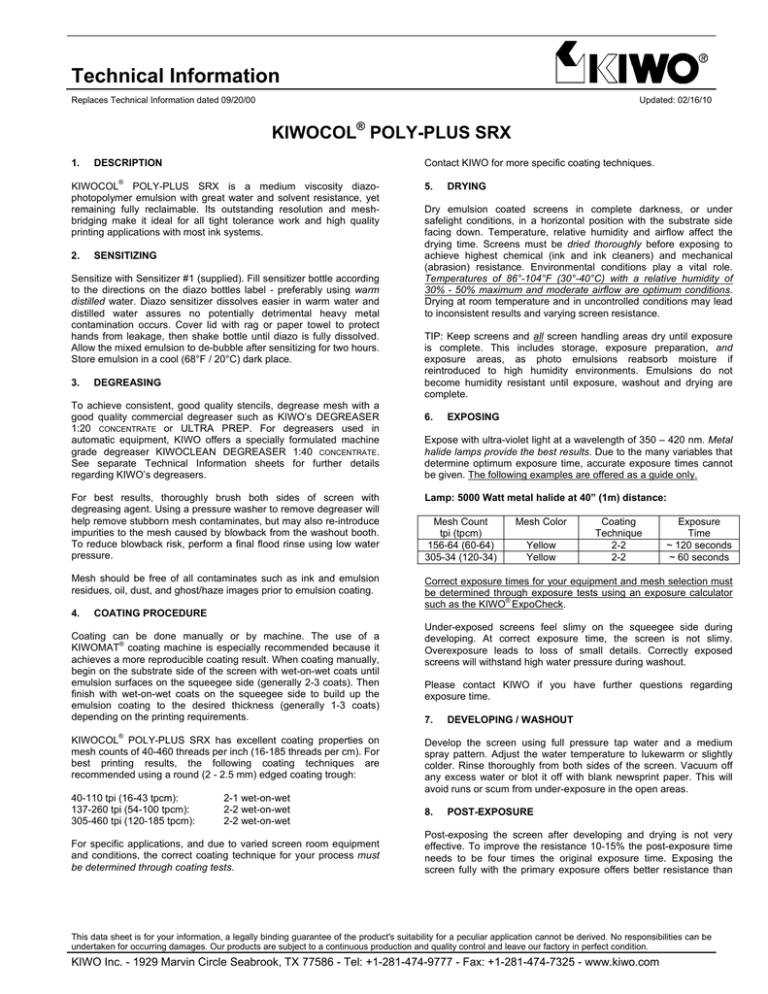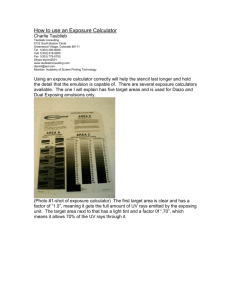Technical Information
advertisement

Technical Information Replaces Technical Information dated 09/20/00 Updated: 02/16/10 KIWOCOL® POLY-PLUS SRX 1. DESCRIPTION Contact KIWO for more specific coating techniques. ® KIWOCOL POLY-PLUS SRX is a medium viscosity diazophotopolymer emulsion with great water and solvent resistance, yet remaining fully reclaimable. Its outstanding resolution and meshbridging make it ideal for all tight tolerance work and high quality printing applications with most ink systems. 2. SENSITIZING Sensitize with Sensitizer #1 (supplied). Fill sensitizer bottle according to the directions on the diazo bottles label - preferably using warm distilled water. Diazo sensitizer dissolves easier in warm water and distilled water assures no potentially detrimental heavy metal contamination occurs. Cover lid with rag or paper towel to protect hands from leakage, then shake bottle until diazo is fully dissolved. Allow the mixed emulsion to de-bubble after sensitizing for two hours. Store emulsion in a cool (68°F / 20°C) dark place. 3. DEGREASING To achieve consistent, good quality stencils, degrease mesh with a good quality commercial degreaser such as KIWO’s DEGREASER 1:20 CONCENTRATE or ULTRA PREP. For degreasers used in automatic equipment, KIWO offers a specially formulated machine grade degreaser KIWOCLEAN DEGREASER 1:40 CONCENTRATE. See separate Technical Information sheets for further details regarding KIWO’s degreasers. 5. DRYING Dry emulsion coated screens in complete darkness, or under safelight conditions, in a horizontal position with the substrate side facing down. Temperature, relative humidity and airflow affect the drying time. Screens must be dried thoroughly before exposing to achieve highest chemical (ink and ink cleaners) and mechanical (abrasion) resistance. Environmental conditions play a vital role. Temperatures of 86°-104°F (30°-40°C) with a relative humidity of 30% - 50% maximum and moderate airflow are optimum conditions. Drying at room temperature and in uncontrolled conditions may lead to inconsistent results and varying screen resistance. TIP: Keep screens and all screen handling areas dry until exposure is complete. This includes storage, exposure preparation, and exposure areas, as photo emulsions reabsorb moisture if reintroduced to high humidity environments. Emulsions do not become humidity resistant until exposure, washout and drying are complete. 6. EXPOSING Expose with ultra-violet light at a wavelength of 350 – 420 nm. Metal halide lamps provide the best results. Due to the many variables that determine optimum exposure time, accurate exposure times cannot be given. The following examples are offered as a guide only. For best results, thoroughly brush both sides of screen with degreasing agent. Using a pressure washer to remove degreaser will help remove stubborn mesh contaminates, but may also re-introduce impurities to the mesh caused by blowback from the washout booth. To reduce blowback risk, perform a final flood rinse using low water pressure. Lamp: 5000 Watt metal halide at 40” (1m) distance: Mesh should be free of all contaminates such as ink and emulsion residues, oil, dust, and ghost/haze images prior to emulsion coating. Correct exposure times for your equipment and mesh selection must be determined through exposure tests using an exposure calculator ® such as the KIWO ExpoCheck. 4. COATING PROCEDURE Coating can be done manually or by machine. The use of a ® KIWOMAT coating machine is especially recommended because it achieves a more reproducible coating result. When coating manually, begin on the substrate side of the screen with wet-on-wet coats until emulsion surfaces on the squeegee side (generally 2-3 coats). Then finish with wet-on-wet coats on the squeegee side to build up the emulsion coating to the desired thickness (generally 1-3 coats) depending on the printing requirements. ® KIWOCOL POLY-PLUS SRX has excellent coating properties on mesh counts of 40-460 threads per inch (16-185 threads per cm). For best printing results, the following coating techniques are recommended using a round (2 - 2.5 mm) edged coating trough: 40-110 tpi (16-43 tpcm): 137-260 tpi (54-100 tpcm): 305-460 tpi (120-185 tpcm): 2-1 wet-on-wet 2-2 wet-on-wet 2-2 wet-on-wet For specific applications, and due to varied screen room equipment and conditions, the correct coating technique for your process must be determined through coating tests. Mesh Count tpi (tpcm) 156-64 (60-64) 305-34 (120-34) Mesh Color Yellow Yellow Coating Technique 2-2 2-2 Exposure Time ~ 120 seconds ~ 60 seconds Under-exposed screens feel slimy on the squeegee side during developing. At correct exposure time, the screen is not slimy. Overexposure leads to loss of small details. Correctly exposed screens will withstand high water pressure during washout. Please contact KIWO if you have further questions regarding exposure time. 7. DEVELOPING / WASHOUT Develop the screen using full pressure tap water and a medium spray pattern. Adjust the water temperature to lukewarm or slightly colder. Rinse thoroughly from both sides of the screen. Vacuum off any excess water or blot it off with blank newsprint paper. This will avoid runs or scum from under-exposure in the open areas. 8. POST-EXPOSURE Post-exposing the screen after developing and drying is not very effective. To improve the resistance 10-15% the post-exposure time needs to be four times the original exposure time. Exposing the screen fully with the primary exposure offers better resistance than This data sheet is for your information, a legally binding guarantee of the product's suitability for a peculiar application cannot be derived. No responsibilities can be undertaken for occurring damages. Our products are subject to a continuous production and quality control and leave our factory in perfect condition. KIWO Inc. - 1929 Marvin Circle Seabrook, TX 77586 - Tel: +1-281-474-9777 - Fax: +1-281-474-7325 - www.kiwo.com Technical Information ® KIWOCOL POLY-PLUS SRX Page 2 of 2 Updated: 02/16/10 under exposing initially, then post-exposing to improve resistance. Post exposure is most often used for long printing runs when water based and/or abrasive inks are used. remove both emulsion haze and ink ghost simultaneously. See separate Technical Information sheets for further details regarding KIWO’s haze removers. 9. Haze removers, like ink washes and stencil removers should be worked into the screen mesh from both sides of the screen before removing for maximum effectiveness. POST-HARDENING (CHEMICALLY) The emulsion can be chemically post-hardened using one of KIWO’s stencil hardeners. Stencil hardeners can be classified as reclaimable or un-reclaimable. 13. PHYSICAL PROPERTIES Viscosity: Viscosity sensitized: approx.: 10,000 mPas approx.: 6,000 mPas Solids Content: approx.: 38% Color: Color Sensitized: blue green Storage: 1 year at 68°F/20°C 10. BLOCKOUT / TOUCH-UP Potlife: 3-5 weeks at 68°F/20°C When printing with plastisol, UV and solvent-based inks, retouching and blocking out can be done with KIWO’s BLOCKOUT, RED BLOCKOUT or KIWOFILLER SR 401 NV. For a water resistance stencil, block out and retouch with KIWOFILLER SWR 22 or use ® KIWOCOL POLY-PLUS SRX (dry thoroughly and re-expose completely prior to using stencil hardeners). See separate Technical Information sheets for further details regarding KIWO’s blockouts. Pre-coated screens: 1-2 weeks in complete darkness at 68°F/20°C Freezing: protect against freezing VOC: none TLV: N/A HMIS rating: Health – 1 Flammability – 0 Reactivity – 0 If reclaiming ability is desired, use KIWO HARDENER WR or HARDENER HP. If a permanent un-reclaimable stencil is desired, for example when cataloging screens for future use, or when aggressive inks are used for very large print runs, use KIWO HARDENER K. See separate Technical Information sheets for further details regarding KIWO’s stencil hardeners. 11. RECLAIMING ® KIWOCOL POLY-PLUS SRX can be reclaimed with KIWO’s STENCIL REMOVER 1:20 CONCENTRATE. Before reclaiming, ensure the screen is completely cleaned of ink or ink cleaning chemical residues. If water beads up on the stencil, residues are still present. If this is the case, degrease the screen again prior to reclaiming for best results. For best results, work both sides of the screen i.e. apply stencil remover, brush, and pressure wash both sides of the screen. After applying stencil remover, a short dwell time may be used prior to pressure washing to allow more working time for the stencil remover especially when using coarser meshes and/or thicker stencils. CAUTION: Never allow stencil removers to dry prior to removal, as the emulsion will become locked into the mesh and virtually impossible to remove. See separate Technical Information sheets for further details regarding KIWO’s stencil removers. 12. HAZE REMOVING To remove emulsion haze or ghost images left from the ink, use KIWO’s HAZE REMOVER, FAST LIQUID HAZE REMOVER, or MEGA CLEAN ACTIVE. For best results, HAZE REMOVER should be applied to a dry screen, then allowed to completely dry on the screen. For more effective ink ghost removal, HAZE REMOVER can be used in ® conjunction with KIWOCLEAN CONCENTRATED INK WASH or ULTIMATE INK WASH to re-activate dried HAZE REMOVER. Active components in FAST LIQUID HAZE REMOVER and MEGA CLEAN ACTIVE work in approximately five minutes and effectively 14. PACKAGING 1 US Quart, 1 US Gallon, 5 US Gallons, 55 US Gallon Drum. 15. ADDITIONAL INFORMATION For additional product information, please visit our web site at www.kiwo.com. All products mentioned in this Technical Information are available through KIWO Inc. and its distributor network. For further information contact your authorized KIWO distributor or KIWO directly. Thank you for choosing KIWO.

